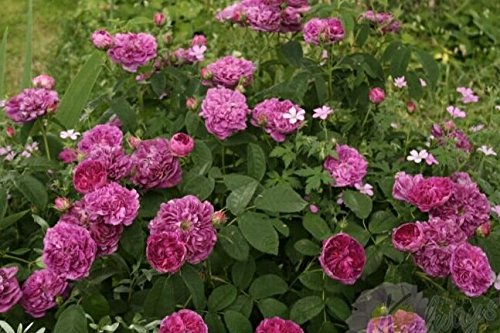
Scientific name: Rosa chinensis Jacq.
Common name: China rose, Chinese tea rose, yue ji hua (China)
The China roses are actually a complex mixture of natural and cultivated hybrids that have evolved over more than three thousand years in Chinese gardens.
At the end of the eighteenth century, as China Roses were prominently introduced to the West, there was a great revolution in the world of roses. The arrival of the China Roses changed the rose world profoundly.
A China gene is thought to be responsible for repeatability of bloom. Up until their introduction, the only cultivated roses with any repeat bloom were the Autumn Damasks. The increased productivity of bloom was greatly prized in the gene pool.
The Chinas brought another dimension to the color range in roses. The Chinas have a unique aspect of defying the color principles commonplace with roses before that time. They have the unusual characteristic of darkening with age. Most of the roses up until that time faded with age. A China Rose may open yellow, then blend to crimson through gradations of orange and pink. This is the case with ‘Mutabilis’. The Chinas broadened the color range to include shades of yellow and a deep crimson that were not known to European garden roses before that time.
The China Roses broadened the scents of roses. New blends became apparent when the Chinas hybridized with other roses.
The China Rose is by far the most exotic rose. With its compact, bushy form and silky flowers, it brings a colorful touch to the garden. The China Rose produces semi-double/double flowers in rich hues of red, pink and yellow. Petitie in its stature, these roses will fill small spaces with brilliance like no other. They are also do well in containers on the patio.
These are pretty roses that flower with constant regularity throughout the season. They form twiggy bushes and are best grown in a sunny spot around the garden or in the front of borders. They are not recommended for shade as plenty of sunshine is required for them to perform to their full potential. The foliage is similar to modern roses but smaller and more dainty. They have their own pleasant fragrance. Minimal pruning is recommended.
Flowers of the China rose can vary greatly in colour and may open red, creamy white, or unusually a beautiful pale pink that later becomes red. This hardy rose is renowned for darkening over time, whereas other species lighten after opening.
In the wild, this is an evergreen climber or large shrub with arching, scrambling branches up to 8 m or more when climbing in trees. The young shoots have hooked crimson thorns, whereas side shoots have fewer, scattered thorns.
Leaves: Leaves have 3, 5 or sometimes 7 lanceolate leaflets, shiny dark green above, paler below, with finely toothed margins. The terminal leaflet is largest, measuring 4.5–6.0 cm long.
Flowers: In the wild form, Rosa chinensis var. spontanea flowers appear on short side shoots from March to May and are single. In the cultivated Rosa chinensis var. chinensis, flowers are single, double or semi-double and appear throughout the year. There are 5 sepals, the largest up to 3 cm long, lanceolate, and reflexed after the flower opens. There are usually 5 petals, each broadly ovate, 3–4 cm long and wide, opening pink, buff or cream with red lines, usually becoming red-purple on exposure to sunlight, sometimes opening red or purplish.
Fruits: The hips (fruits) are round and green, becoming orange-yellow, with usually only 2 or 3 large seeds per hip and a hard seed coat.
Rosa chinensis is used in traditional Chinese medicine . Roots and fruits are used for treating arthritis, boils, cough, haemuturia and rheumatoid joint pains. The fruit is applied to sprains, ulcers and wounds.
Flower buds are used as a tonic, circulatory stimulant, emmangogue (stimulating blood flow in the pelvic area and uterus) and menstrual regulator and for chest and abdominal pain . The flowers contain an aromatic essential oil. The fruit, flowers and young shoots are edible.
China rose is the ancestor of many of the popular cultivar groups of roses, such as hybrid tea and floribunda, so common in gardens today.
If you have any information,questions, or feedback you would like to include in this webpage.
Please email momo19@naturekingdoms.com or leave your comments below.